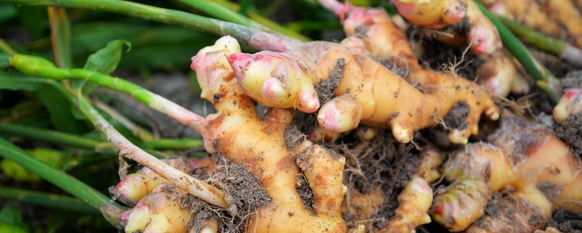Ginger is one of those spices—at least for me—that I’d much rather have the flavor of fresh ginger versus using dried spice, but I’m not always great at keeping some in the refrigerator. If you’re the same as me, you will benefit from growing your own, so you have access to it whenever you need it.
Similarly to garlic, ginger is great to have on hand and doesn’t take up much space or need much attention from you. Plants can be grown indoors or out, depending upon your climate, and prefer part sun, moderate water, and low-nitrogen fertilizers. You can either harvest young ginger or wait until plants are at full maturity.
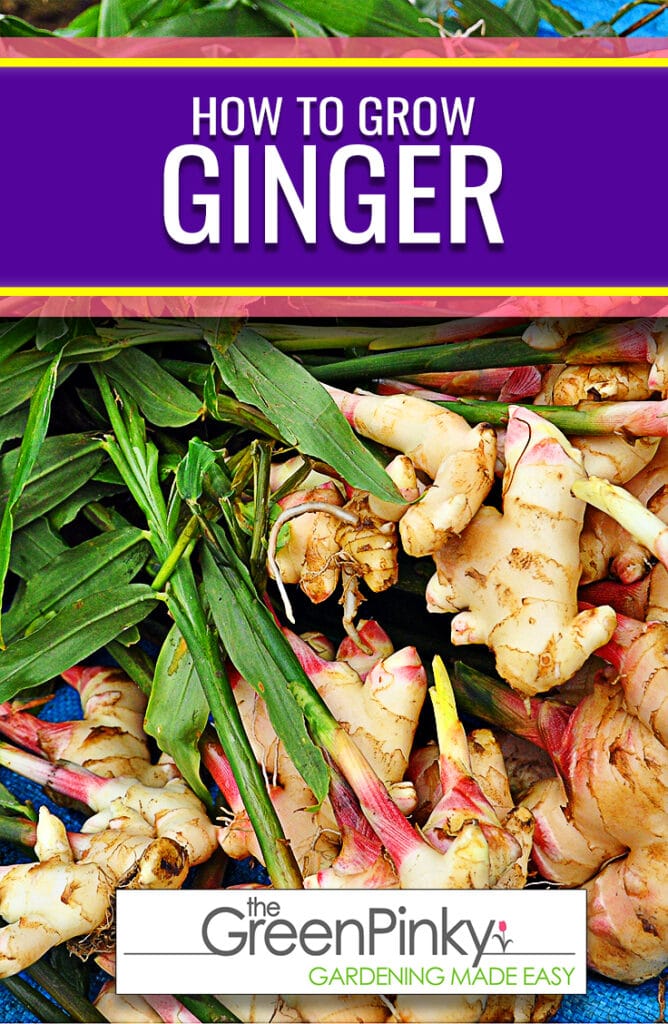
General Information
Ginger (Zingiber officinale) is a perennial tropical herb grown from rhizomes. It is hardy in USDA growing zones 8 to 11 and is perfectly content growing in garden beds where feasible or a container, both indoors or outside. Plants are mainly grown for culinary use, with the ginger roots used in cooking and for medicinal uses.
Soil Prep
Like other root crops that grow below ground, ginger does best when the garden soil is correctly prepped before planting. Since the rhizomes form beneath the soil surface, the soil must be free of rocks and tilled very well to create a loose, friable garden bed. Plants also prefer highly fertile soil that drains well.
To prepare your garden beds for planting, dig down about ten to twelve inches deep. Pick out any trash, large rocks, and all other debris. Add several inches of decomposed manure or finished compost and work the soil well with a rototiller, or by hand, a second time to incorporate the amendment.
Avoid planting in heavy clay soils if possible. Soils with a high percentage of clay hinder the growth and maturation of rhizomes, leading to a stunted, smaller harvest. Heavy soil may also result in the roots having physical deformities.
Planting
You need to purchase the roots and plant sections or portions, similar to planting potatoes to plant ginger. When getting your planting material, it’s best to purchase rhizomes from a reputable online source or local nursery. Ginger purchased from your local grocery store is usable, but it may have spotty results unless you buy organic produce.
The produce in the store is usually sprayed with a growth inhibitor to keep it from sprouting in the store; this inhibitor thus reduces the chance of it growing in the ground.
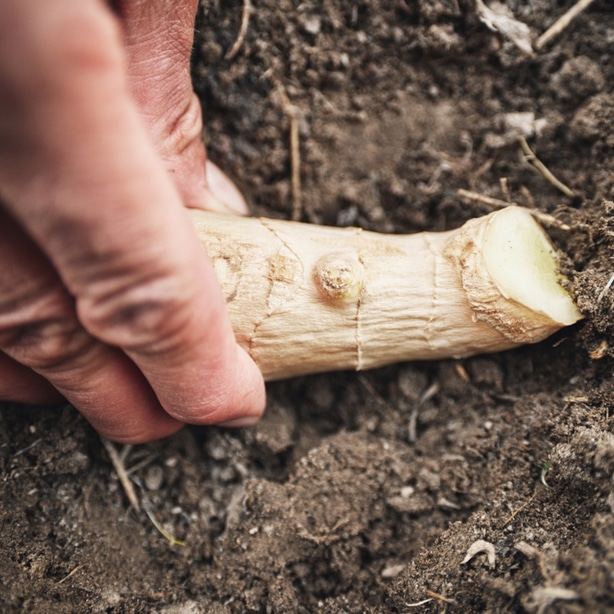
Timing
Since ginger is a tropical plant by origin, wait until after the danger of frost has passed in early spring to plant rhizomes. Soil temperatures should be greater than 68°F, with the ideal temperature about 77°F. This is typically late April or early May. You can sprout it indoors in cooler climates and then transplant it outside when it’s warm enough.
Preparation
- (Optional) Soak store-bought rhizomes in warm water overnight to remove as much of the growth inhibitor as possible.
- Cut the root into pieces. Each portion needs to be 1 to 1 ½ inches long, with each part containing a growth bud or nodule.
- Set pieces in a location out of direct sunlight for a couple of days to allow them to callus. Callous formation helps to prevent them from root rot once planted.
Spacing
The easiest way to plant the pieces is by digging troughs in the garden bed 3-4” deep with rows spaced at least a foot apart. Place the rhizomes pieces 6 to 8 inches apart within the trough, so they are 2 to 4 inches deep, with the growth buds pointing upward if they are easily noticeable.

General Care
Sunlight
Plants grow best when they are in partial sun to partial shade, unlike most other garden plants. The best sun exposure is where they are in partial shade with some filtered or diffused sunlight. This means they grow well next to taller garden plants. Try to avoid planting them in full sun or full shade.
Watering
Due to the high water content of the rhizomes, ginger has moderate watering needs. On average, they need at least one inch of moisture every week. If this isn’t occurring through rainfall, supplement with irrigation but don’t let the soil get waterlogged. The roots don’t like soggy soil. As the weather begins to cool in the fall, cut back on watering.
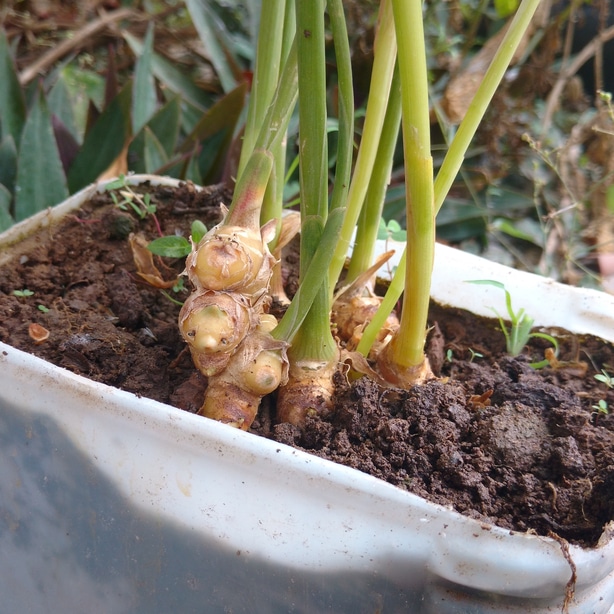
Fertilizing
When fertilizing your plants, be careful not to give them too much nitrogen. High nitrogen leads to excessive foliage growth; instead, they need higher phosphorus or potassium levels to produce blooms and grow the rhizomes. Apply a lower-nitrogen liquid fertilizer (5-10-10 or 10-20-20) right after the shoots emerge and then monthly during active growth.
Weeding
With such a shallow root system, weed competition can dangerously reduce the resources your plants have access to. To prevent competition for water and nutrients, remove weeds by hand when they sprout up close to your plants, especially when they are still seedlings. Avoid using a hoe to weed because you can damage the rhizomes.
Pest and Disease Management
Keep a close eye on your plants for sucking pests like aphids, thrips, red spider mites, and fungus gnats. If you find any, you can quickly treat plants by spraying them with insecticidal soap. Also, watch for common diseases such as rhizome rot, rhizome scale, and soft rot, treating as necessary.
Harvesting
After sprouting, it tasks about 10-12 months until the roots are ready for harvest. Plants are ready when the leaves are yellow and dry and the stems start to fall over. Use your hands to remove the outer rhizomes if you live in a warm climate, or harvest the entire plant if you get freezing temperatures during the winter.
In warm climates, you can leave some rhizomes in the ground, and the plant will continue to grow. Growth will slow during the winter as the plant goes dormant but will resume in the spring with new shoots.
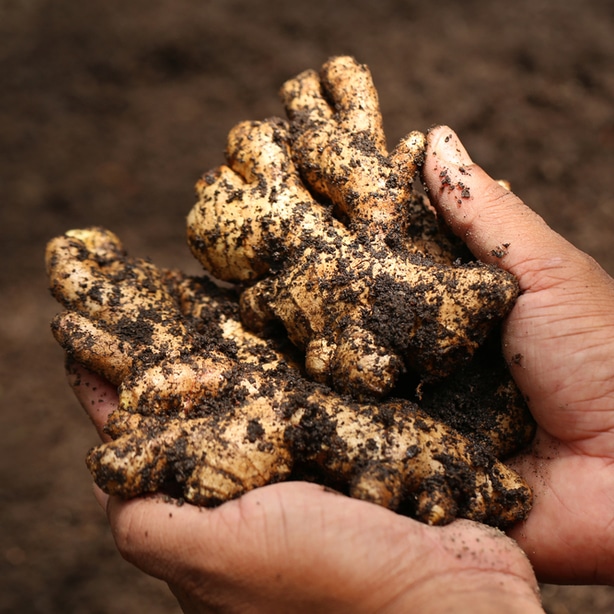
Tips for Growing Ginger
- When plants are in bloom, snip off the beautiful, fragrant blossoms to arrange bouquets. Removing the flowers doesn’t hurt the plants in any way.
- Instead of giving plants a drink of water daily, or every couple of days, give them a deep watering once or twice a week.
- When planting rhizomes, if there are any clipped leaf stalks on the pieces, plant them, so they protrude above the soil surface.
- After blooms die off for the season, do not cut back the foliage if it is still green. The leaves continue to gather sunlight and photosynthesize, providing energy for the plant.
- If growing in containers, choose pots that are more wide and shallow with drainage holes versus narrow and deep. The rhizomes grow horizontally, not vertically like plants with a long taproot.
- If you are over-wintering your plants, cover the soil with straw or mulch in the winter to insulate the ground and give them an extra layer of protection.

